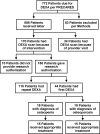Population informatics-based system to improve osteoporosis screening in women in a primary care practice
- PMID: 20190066
- PMCID: PMC3000786
- DOI: 10.1136/jamia.2009.002436
Population informatics-based system to improve osteoporosis screening in women in a primary care practice
Abstract
Objective: To study the effects of using a population-based informatics system for osteoporosis screening and treatment in women aged 65 years or older.
Design: A population-based informatics system (PRECARES: PREventive CAre REminder System) was implemented to meet the needs of the workflow of a primary care practice. Patients treated in either of two sections of a primary care internal medicine department were selected for the intervention, and patients of a comparable third section served as the control group. PRECARES identified women in the intervention group who were due for osteoporosis screening on the basis of age and who had no record of previous screening in our clinical system. If these eligible patients did not have an upcoming outpatient appointment, appointment secretaries sent a letter requesting that they call to make an appointment for a dual-energy x-ray absorptiometry scan.
Measurements: At baseline and 3 months after the letters were sent, a database was used to determine the rate of osteoporosis screening in the intervention and control groups.
Results: A total of 689 patients in the intervention group were sent the letter. Three months after the letters were sent, the rate of osteoporosis screening was 76.4% (2409/3152) in the intervention group vs 69% (928/1344) in the control group (p<0.001). In the intervention group, 25% of the 689 patients responded to the letter and completed osteoporosis screening. Patients who had osteoporosis screening received appropriate treatment.
Conclusion: A population-based informatics system for primary care practice significantly improved the rate of osteoporosis screening.
Conflict of interest statement
Figures
Similar articles
-
Web-based proactive system to improve breast cancer screening: a randomized controlled trial.Arch Intern Med. 2007 Mar 26;167(6):606-11. doi: 10.1001/archinte.167.6.606. Arch Intern Med. 2007. PMID: 17389293 Clinical Trial.
-
Non-visit-based cancer screening using a novel population management system.J Am Board Fam Med. 2014 Jul-Aug;27(4):474-85. doi: 10.3122/jabfm.2014.04.130319. J Am Board Fam Med. 2014. PMID: 25002002 Clinical Trial.
-
Cervical cancer screening: a prospective cohort study of the effects of historical patient compliance and a population-based informatics prompted reminder on screening rates.J Eval Clin Pract. 2014 Apr;20(2):136-43. doi: 10.1111/jep.12098. Epub 2013 Nov 18. J Eval Clin Pract. 2014. PMID: 24237657
-
Osteoporosis: what are the implications of DEXA scanning 'high risk' women in primary care?Fam Pract. 2003 Jun;20(3):289-93. doi: 10.1093/fampra/cmg310. Fam Pract. 2003. PMID: 12738698
-
Screening for osteoporosis in the adult U.S. population: ACPM position statement on preventive practice.Am J Prev Med. 2009 Apr;36(4):366-75. doi: 10.1016/j.amepre.2009.01.013. Am J Prev Med. 2009. PMID: 19285200 Review.
Cited by
-
Use of a clinical decision support system to increase osteoporosis screening.J Eval Clin Pract. 2012 Feb;18(1):89-92. doi: 10.1111/j.1365-2753.2010.01528.x. Epub 2010 Aug 15. J Eval Clin Pract. 2012. PMID: 20722888 Free PMC article.
-
Does pre-ordering tests enhance the value of the periodic examination? Study Design - Process implementation with retrospective chart review.BMC Health Serv Res. 2011 Sep 13;11:216. doi: 10.1186/1472-6963-11-216. BMC Health Serv Res. 2011. PMID: 21914198 Free PMC article.
-
Health behaviors and quality of life predictors for risk of hospitalization in an electronic health record-linked biobank.Int J Gen Med. 2015 Aug 11;8:247-54. doi: 10.2147/IJGM.S85473. eCollection 2015. Int J Gen Med. 2015. PMID: 26316799 Free PMC article.
-
Applying operations research to optimize a novel population management system for cancer screening.J Am Med Inform Assoc. 2014 Feb;21(e1):e129-35. doi: 10.1136/amiajnl-2013-001681. Epub 2013 Sep 16. J Am Med Inform Assoc. 2014. PMID: 24043318 Free PMC article.
-
Use of health information technology to reduce diagnostic errors.BMJ Qual Saf. 2013 Oct;22 Suppl 2(Suppl 2):ii40-ii51. doi: 10.1136/bmjqs-2013-001884. Epub 2013 Jul 13. BMJ Qual Saf. 2013. PMID: 23852973 Free PMC article. Review.
References
-
- U.S. Department of Health and Human Services Bone health and osteoporosis: a report of the Surgeon General. Rockville, MD: U.S. Department of Health and Human Services, Office of the Surgeon General, 2004
-
- Burge R, Dawson-Hughes B, Solomon DH, et al. Incidence and economic burden of osteoporosis-related fractures in the United States, 2005-2025. J Bone Miner Res 2007;223:465–75 - PubMed
-
- U.S. Preventive Services Task Force Screening for osteoporosis: topic page [Internet]. Rockville, MD: U.S. preventive services task force, agency for healthcare research and quality, 2002. [cited 2008 Jun 30]: http://www.ahrq.gov/clinic/uspstf/uspsoste.htm
-
- National Osteoporosis Foundation Clinician's guide to prevention and treatment of osteoporosis. Washington, DC: National Osteoporosis Foundation, 2008
-
- Gallagher TC, Geling O, Comite F. Missed opportunities for prevention of osteoporotic fracture. Arch Intern Med 2002;162:450–6 - PubMed
Publication types
MeSH terms
LinkOut - more resources
Full Text Sources
Medical
Miscellaneous


